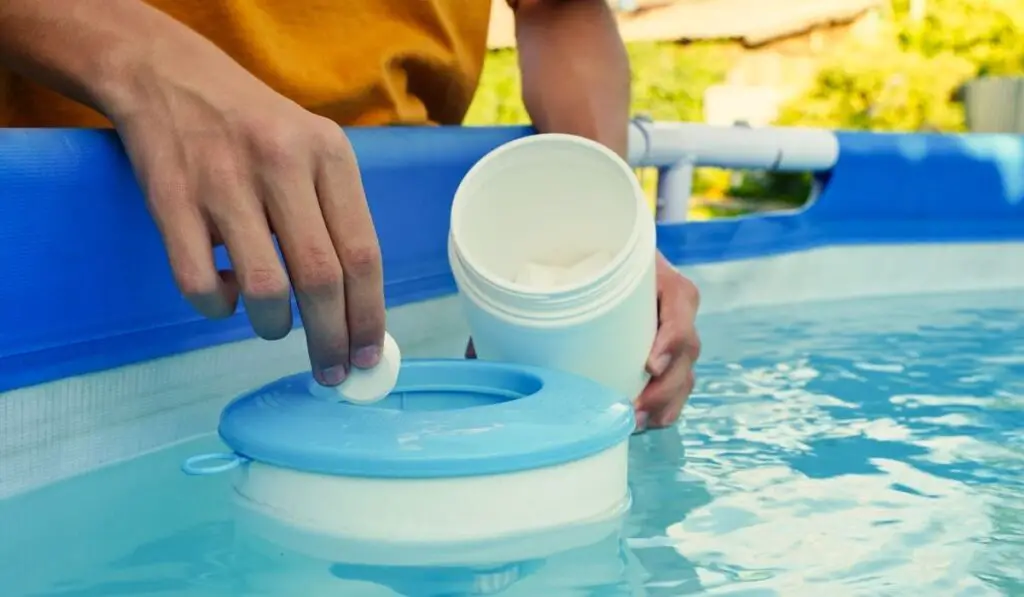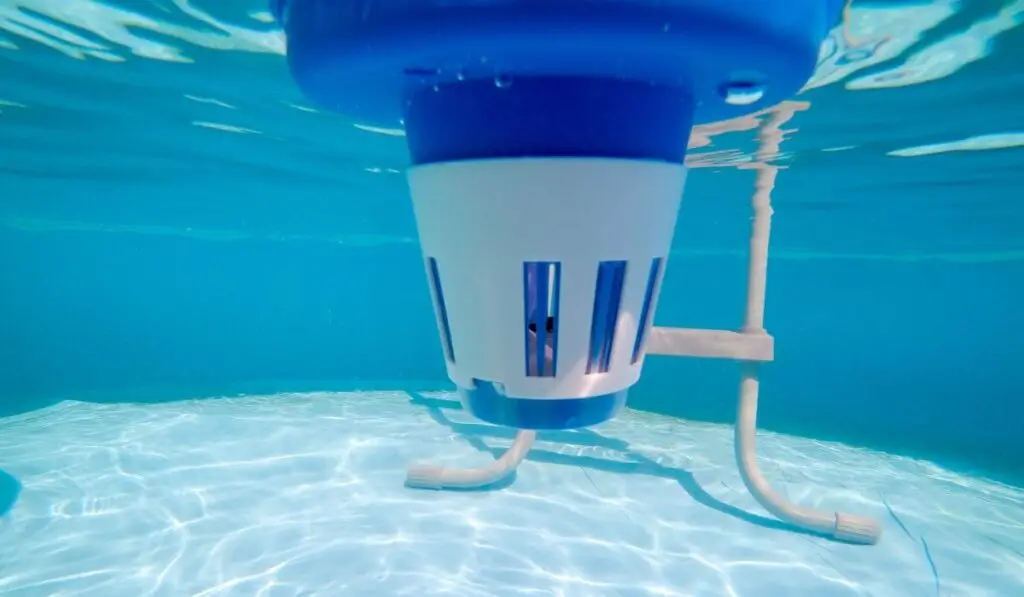Between researching how to get rid of algae to skimming leaves and bugs away, it’s not a stretch to say that your primary job as a pool owner is to protect your water from microscopic intruders. When it comes to managing the level of bacteria in your pool, it’s important to recognize that sanitizer is foundational to basic pool chemistry. Using chlorine tablets is an easy way to sanitize your pool. But can you just toss them into the water and call it a day?
Chlorine tablets should never be thrown directly into the pool. When chlorine tablets sink to the bottom of the pool and dissolve there, they can cause damage or leave a permanent bleach stain. Instead, consider placing tablets in a floating dispenser, pool skimmer, or automatic pool chlorinator.
No one wants a pool that is filled with bacteria, pollution, and toxicity. Chlorine tablets are a convenient way sanitize your pool, especially because they disperse chlorine more steadily than chlorine granules. Before we delve fully into why you should be using chlorine tablets, let’s look at how and where you should be adding chlorine tablets to your pool.
Can You Put Chlorine Tablets Directly In Your Pool?

Chlorine tablets are simple to use, but like with anything else, there are proper and improper ways of handling them. When used incorrectly, they can damage your pool and waste your money. Tossing chlorine tablets into your pool and walking away is definitely the wrong way to use them.
Never throw chlorine tablets directly into your pool or let them to dissolve on the pool floor. When chlorine tablets are left on the floor of your pool, they can bleach liners and cause permanent staining. This is also a comparatively ineffective method of using them.
Tablets that are left on your pool floor are not close to the skimmer line of the pool. Consequentially, they dissolve very slowly and dispense sanitizer unevenly. Using the chlorine tablets in this way will get most of the chlorine wasted anyway, so you will eventually need to use more.
Where Should You Put Chlorine Tablets in an Above-Ground Pool?
There are many ways of adding chlorine tablets to your pool to maintain its purity and cleanliness.
Floating Chlorine Dispenser
Chlorine floaters are available in various sizes and fun shapes, like the XY-WQ (on Amazon). They’re also easy to use and affordable. All you have to do is pop chlorine tablets inside the floater and let it set sail. These plastic pool devices move around the pool and release sanitizer as the chlorine tablets dissolve.
Floating dispensers are simple and require little maintenance, however, they may not be the ideal option for you if you own a pool liner. Sometimes, floating dispensers can become stuck and release excessive amounts of chlorine in one spot, leading to discoloration and even damage to your pool liner.
Plus, these devices are passive, so the chlorine is dispensed unevenly without water flowing over them through the circulation of your pool water. Taking into account the potential damage to your pool liner, you may find that the relative convenience of floating dispensers isn’t worth the anxiety.
Pool Skimmer
A more effective method of using chloring tablets is to add them to a swimming pool skimmer. You can place the tablets into the skimmer basket, and water will flow quickly over them whenever the filter is running. Then the chlorinated water is sent out of the return jets into the water, so the chlorine is distributed evenly across the pool.
Filters typically only run for about 8 to 12 hours in a day. As a result, one potential disadvantage of putting chlorine tablets in the skimmer basket is that the tablets will dissolve even when the filter isn’t running. Without proper maintenance, this can result in extremely chlorinated and corrosive water that can destroy your equipment, including the skimmer’s filter itself.
You can resolve this problem by taking out the partially dissolved tablets whenever you’re not running your pool filter or by setting up a variable speed pool pump (like this Black + Decker model on Amazon) that will continuously cycle water without racking up high electric bills.
Automatic Pool Chlorinator
Our preferred method of dispersing chlorine tablets is by using an automatic chlorine dispenser or chlorinator (also called a chemical feeder). If you want a more surefire way of not going overboard with the chlorine tablets, you should go for a pool chlorinator like the CL200 in-line pool chlorinator (on Amazon).
Chlorinators usually operate at the filter site and use either liquid chlorine, chlorine tablets, or granular chlorine, as specified by the equipment. When you put tablets inside a chlorinator, you set the chlorine level between the optimal range of 1 part per million (ppm) to 3 ppm.
Using test strips, you then confirm this level until you arrive at the ideal setting for your pool according to factors like the weather, water quality, and usage.
With the appropriate settings, a chlorinator ensures a balance of chlorine levels: not too high that the water becomes acidic, but not too low that promotes the growth of green algae and bacteria. While you should still test your water every day to ensure optimal levels, an automated chlorinator allows for less daily maintenance.
Using chlorinators is the most convenient and effective way to supply your pool with chlorine tablets because unlike other devices, chlorinators keep chlorine levels consistent and even.
However, you must always ensure that the pool water flows over your chlorinator last before flowing back into the pool in order to guarantee clear, clean, and well-chlorinated water.
Chlorine Granules
You can directly sprinkle a pulverized form of chlorine tablets, AKA chlorine granules, into pool water. Take note, though, that chlorine granules work at a more localized level than the other three methods, so they aren’t as effective.
Manually mixing in chlorine granules also takes more time, as you need to do a lot of measuring. Similar to when you use a chemical floater, chlorine granules can also destroy your equipment or bleach your liner if too much chlorine accumulates in one place.
Remember that whole chlorine tablets should NEVER be directly dispersed into the water. It puts the health of swimmers at risk and will lead to chlorine levels that will ruin your pool.

How Much Chlorine Should You Use In Your Pool?
The ideal chlorine concentration for your swimming pool is between a minimum of 1 part per million (ppm) a maximum of 3 ppm. This is a safe range that is effective for protection against contaminants without the risks of excessive amounts of chlorine in the water, like irritation in the throat, eyes, nose, and lungs.
It’s important to test the pool water regularly to make sure that your pool contains the appropriate amount of sanitizer. You can determine the precise levels of chlorine and other chemicals in your pool with the use of test kits such as test strips and then adjust as needed.
Why Should You Use Chlorine Tablets in Your Pool?
You’re probably wondering why our focus is on chlorine tablets and not on chlorine in general. This is simply because it’s easier to use chlorine tablets. They dispense chlorine at a more measured rate than throwing scoops of chlorine granules in the pool, which takes a lot of careful measuring.
How Do You Choose the Right Chlorine Tablets for Your Pool?
Chlorine tablets are available in one-inch and three-inch tablet sizes. You’re advised to go with the three-inch tablets because you can handle them more easily, and depending on how popular they are in your area, they might be less expensive than the one-inch tablets.
One other advantage of the three-inch tablets is their ability to sanitize 5,000 gallons of water, which means you can use a smaller amount and therefore save money. A little goes a long way.
To determine the right number of tablets for your pool, you must know the volume of your pool. Round up the volume of your pool up to the nearest 5,000 gallons unit to use the correct number of tablets.
For example, if the capacity of your pool is 20,000 gallons, use four chlorine tablets. If your pool volume is 16,000 gallons, you should also use four three-inch chlorine tablets because you’re rounding up to the next 5,000 gallons. Easy peasy.
